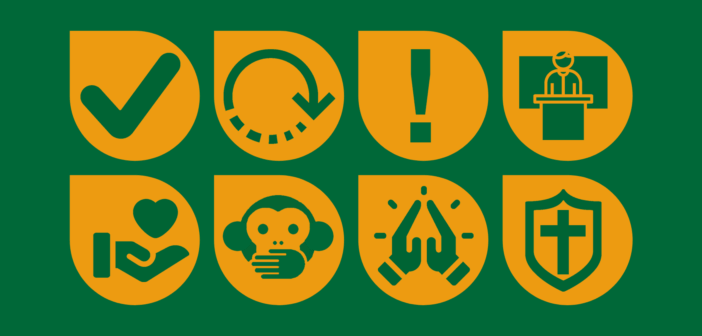Bob Whitesel has watched many online Sunday services to identify recurring weaknesses and help churches improve their livestreaming. He offers eight practical suggestions for engaging online worshipers more effectively.
1. Be your genuine self.
Many watchers flip around to various online services, listening to just a few minutes of each, to find one with which they can relate. It is an opportunity for incognito church shopping. So, be yourself. Be a genuine reflection of the styles, personality and liturgy of your church meetings.
Sometimes leaders consider a video service as an opportunity to try new things or create new impressions. Leaders may convey an impression of a larger live audience than usually congregates. Or leaders may experiment with acoustic worship because the leader prefers an “un-plugged style.” At other times, I’ve seen leaders broadcast the service from their living room dressed casually.
Rather, try to give the visitor a true and authentic sense for the styles, atmosphere, and culture of your church worship service. That way if they one day visit a face-to-face venue they will not be surprised. For example, if your congregation dresses up for Sunday, then dress up a bit even when broadcasting from your living room.
2. Transitions
Work on transitions to create uninterrupted flow between different liturgical elements, worship, and preaching. It may be best to prerecord the service so these transitions can be smoothly edited together. Some churches try to approximate live services by streaming live. Yet because most churches have little experience with online worship, this often creates glitches that interrupt the connection between the listener and the Lord.
3. Immediacy
If you prerecord the message, do so only a few days before broadcasting it. It’s important not to just rebroadcast earlier sermons but to talk about topics of immediate concern to listeners. Talking about suffering and fear are important and timely topics. Romans 8:31 reminds us that when we face calamity, “What, then, shall we say in response to these things? If God is for us, who can be against us?”
4. Presentation
Some churches will have the pastor behind the pulpit, recreating their sanctuary atmosphere for the watchers. Others will utilize a studio format. In both circumstances, I’ve notice two recurring distractions. First, when the lessons, verses, etc. are put on a screen behind the speaker, they are often not legible. However, if a service is recorded a few days earlier, then these can be inserted electronically. This makes the words more legible. Second, stage lighting is often poor. Most leaders know they need at least two front lights, shining from slightly above and from the left and right, but most leaders do not know that an additional “backlight” is necessary to yield a sense of depth and a 3-D feel. Without at least one backlight, a speaker will look two-dimensional and inauthentic, like a cardboard cutout. Backlighting is also needed at face-to-face events, so make sure you add it to your face-to-face venues as well.
5. Connecting via follow-up and giving
Place a permanent title on your streaming page with your home page URL. Also, every church homepage should have three things prominently displayed: how to contact us, event times, location. Most churches also list online giving options. Yet, many pastors feel awkward when it comes to the offering. This may be because they are criticized for overemphasizing or underemphasizing it. So, take time during the week to prepare and record what you will say about the offering. Pray over it and use scripture to help watchers see that generosity is not only a spiritual discipline but is also something dearly needed during trying times.
6. Ignore, don’t criticize technical problems.
When you are recording live or even prerecording, glitches will always creep in. When technical difficulties occur, a leader will usually feel compelled to point out the problem and apologize. But to the many hardworking tech people, drawing attention to a glitch even through an apology feels like public criticism. For most churches, online worship expressions are a new frontier. And in that frontier, it is experimentation, failures, and successes that should be expected as part of the pioneer life.
7. Lead people to an encounter with God.
Electronic mediums create physical distancing but not between people and God. Pioneers like Billy Graham and Charles Fuller used radio in its infancy to lead people to an encounter with Christ. Today it’s important that church leaders foster a connection between the watcher and God. Leaders should create times during the service when the watchers feels that God is right there with them, speaking to them and ministering to them. A preacher should make this the apex of the sermon. And worship leaders should make this the focus of their time for planning and prayer.
8. It is normal to be worried and scared, but trust God.
Are you worried, frustrated, or just uncomfortable with remote leadership? Paul felt the same way, yet he stated, “I was unsure of how to go about this, and felt totally inadequate — I was scared to death, if you want the truth of it — and so nothing I said could have impressed you or anyone else. But the Message came through anyway. God’s Spirit and God’s power did it, which made it clear that your life of faith is a response to God’s power, not to some fancy mental or emotional footwork by me or anyone else.” (1 Cor. 2:4-5. MSG).
This article is adapted from Growing the Post-pandemic Church by Bob Whitesel. The book is available at churchleadership.press and Amazon. Used by permission.
Related Resources
- 3 Myths about Digital Worship by Tim Snyder
- What Approach to Digital Worship Is Best for Your Church? by Tim Snyder






